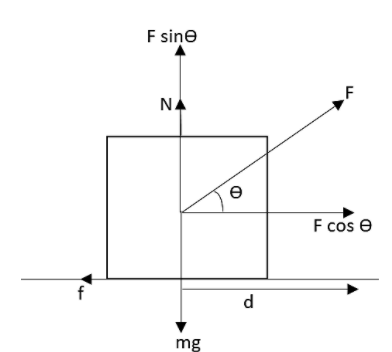
A block having a mass $m$ is pulled by applying a force at an angle $\theta $ with the horizontal along a horizontal surface. Let us assume that the block travels with a uniform velocity and is having a displacement $d$ and the coefficient of friction is $\mu $, therefore the work done by the applied force can be written as,
$\begin{align}
& A.\dfrac{\mu mgd}{\cos \theta +\mu \sin \theta } \\
& B.\dfrac{\mu mgd\cos \theta }{\cos \theta +\mu \sin \theta } \\
& C.\dfrac{\mu mgd\sin \theta }{\cos \theta +\mu \sin \theta } \\
& D.\dfrac{\mu mgd\cos \theta }{\cos \theta -\mu \sin \theta } \\
\end{align}$
Answer
568.8k+ views
Hint: The balancing of the force acting on the body is to be found first. This is to be found both in the horizontal as well as vertical direction. From this find out the external force acting on the body. Using this calculate the work done by the applied force on the block. This information will help you to solve this question.
Complete step by step answer:

From the figure we can write that the total force acting on the block is balanced as it is in equilibrium.
In vertical direction we can write that,
$N+F\sin \theta =mg$
Where $N$be the normal force acting on the body, $\theta $ be the angle at which force acts, $F$ be the force applied on the block, $g$ be the acceleration due to gravity and $m$ be the mass of the particle.
The equation can be rewritten as,
$N=mg-F\sin \theta $
In the horizontal direction, we can see that the block is moving with a fixed velocity. Therefore the cosine component of the force is balanced by the frictional force $f$. That is,
$f=F\cos \theta $
The friction is given by the equation,
$f=\mu N$
Substituting this in the equation will give,
\[\mu N=F\cos \theta \]
The normal force can be substituted by the equation we obtained above. That is,
\[\begin{align}
& \mu \left( mg-F\sin \theta \right)=F\cos \theta \\
& \Rightarrow F=\dfrac{\mu mg}{\cos \theta +\mu \sin \theta } \\
\end{align}\]
The work done by the external force can be obtained as,
\[W=F\cdot S\]
Where \[S\]be the displacement of the block given as,
\[S=d\cos \theta \]
Therefore the work done will be,
\[W=\dfrac{\mu mgd\cos \theta }{\cos \theta +\mu \sin \theta }\]
The answer is mentioned as option B.
Note:
The work done is defined as the amount of energy dissipated when there is a displacement occurring due to an external force acting. Work is expressed in the units of joule. The work done is a scalar quantity which is not dependable on the direction.
Complete step by step answer:

From the figure we can write that the total force acting on the block is balanced as it is in equilibrium.
In vertical direction we can write that,
$N+F\sin \theta =mg$
Where $N$be the normal force acting on the body, $\theta $ be the angle at which force acts, $F$ be the force applied on the block, $g$ be the acceleration due to gravity and $m$ be the mass of the particle.
The equation can be rewritten as,
$N=mg-F\sin \theta $
In the horizontal direction, we can see that the block is moving with a fixed velocity. Therefore the cosine component of the force is balanced by the frictional force $f$. That is,
$f=F\cos \theta $
The friction is given by the equation,
$f=\mu N$
Substituting this in the equation will give,
\[\mu N=F\cos \theta \]
The normal force can be substituted by the equation we obtained above. That is,
\[\begin{align}
& \mu \left( mg-F\sin \theta \right)=F\cos \theta \\
& \Rightarrow F=\dfrac{\mu mg}{\cos \theta +\mu \sin \theta } \\
\end{align}\]
The work done by the external force can be obtained as,
\[W=F\cdot S\]
Where \[S\]be the displacement of the block given as,
\[S=d\cos \theta \]
Therefore the work done will be,
\[W=\dfrac{\mu mgd\cos \theta }{\cos \theta +\mu \sin \theta }\]
The answer is mentioned as option B.
Note:
The work done is defined as the amount of energy dissipated when there is a displacement occurring due to an external force acting. Work is expressed in the units of joule. The work done is a scalar quantity which is not dependable on the direction.
Recently Updated Pages
Why are manures considered better than fertilizers class 11 biology CBSE

Find the coordinates of the midpoint of the line segment class 11 maths CBSE

Distinguish between static friction limiting friction class 11 physics CBSE

The Chairman of the constituent Assembly was A Jawaharlal class 11 social science CBSE

The first National Commission on Labour NCL submitted class 11 social science CBSE

Number of all subshell of n + l 7 is A 4 B 5 C 6 D class 11 chemistry CBSE

Trending doubts
What is meant by exothermic and endothermic reactions class 11 chemistry CBSE

10 examples of friction in our daily life

One Metric ton is equal to kg A 10000 B 1000 C 100 class 11 physics CBSE

1 Quintal is equal to a 110 kg b 10 kg c 100kg d 1000 class 11 physics CBSE

Difference Between Prokaryotic Cells and Eukaryotic Cells

What are Quantum numbers Explain the quantum number class 11 chemistry CBSE




